 Hey! It worked once, it will work again. It’s been six years. There are a lot of new hungry politicians. Let’s give it a try. And so there it was, in 1791, the First Bank of the United States. Not only deceptively named to sound official, but also to take attention away from the real first bank, the Bank of North America, which had been shut down.
Hey! It worked once, it will work again. It’s been six years. There are a lot of new hungry politicians. Let’s give it a try. And so there it was, in 1791, the First Bank of the United States. Not only deceptively named to sound official, but also to take attention away from the real first bank, the Bank of North America, which had been shut down.True to its British model, the name of the investors were never revealed.
Having gotten away with it a second time, some of them probably wished Amshall Rothschild had picked a different time to make his pronouncement from his private central bank in Frankfurt.
“Let me issue and control a nation’s money and I care not who writes the laws.”
Mayer Amschel Rothschild, 1790
Not to worry, no one was listening. The American government borrowed 8.2 million dollars from the bank in the first 5 years and prices rose by 72%. This time round the money changer’s had learned their lesson, they had guaranteed a twenty year charter.
The president, who could see an ever increasing debt, with no chance of ever paying back, had this to say.
“I wish it were possible to obtain a single amendment to our Constitution – taking from the federal government their power of borrowing.”
Thomas Jefferson, 1798
While the independent press, who had not been bought off yet, called the scam “a great swindle, a vulture, a viper, and a cobra.”
As with the real first bank, the government had been the only depositor to put up any real money, with the remainder being raised from loans the investors made to each other, using the magic of fractional reserve banking.
When time came for renewal of the charter, the bankers were warning of bad times ahead if they didn’t get what they wanted. Yet, the charter was not renewed.
Then, just five months later, Britain attacked America and started the war of 1812.
Meanwhile, and a short time earlier, an independent Rothschild business, the Bank of France, was being looked upon with suspicion by none other than NAPOLEON (1803 – 1825)
